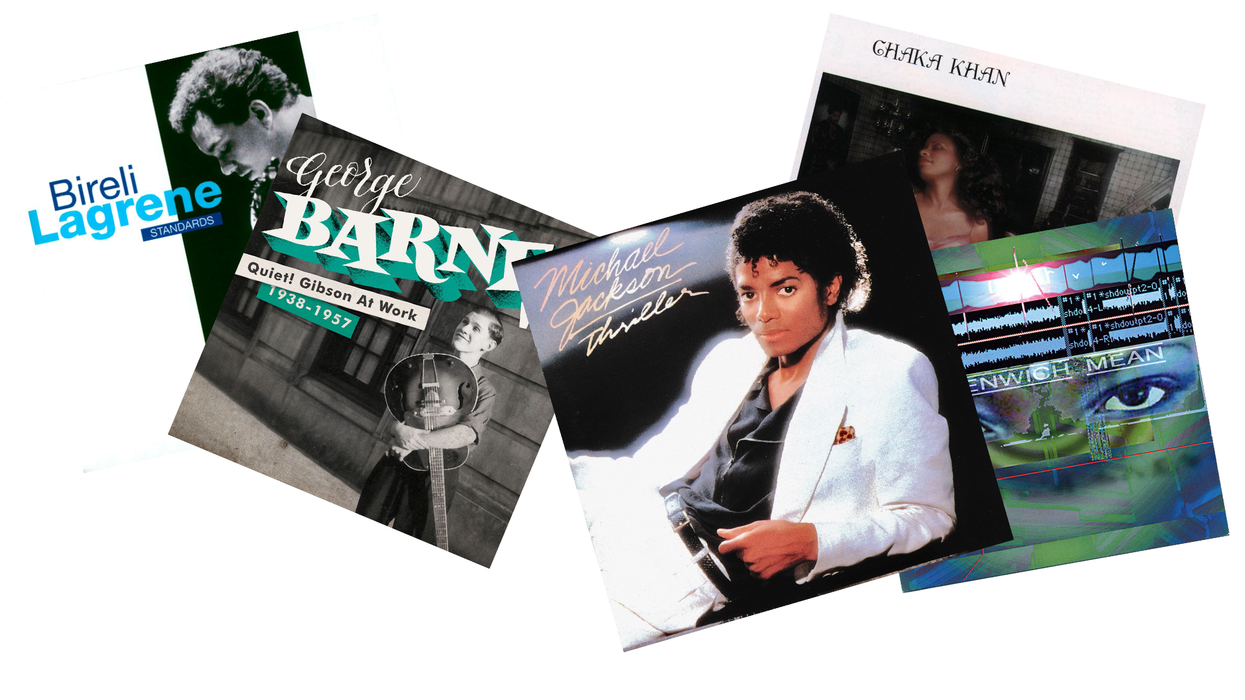Come along for the ride as Stern stuns the 1987 Newport Jazz Festival crowd, taking them from quiet jazz meditations to soaring blues-drenched crescendos.
Throughout my college years, I spent countless nights at New York City’s now-defunct 55 Bar, sitting literally six feet away from guitarist Mike Stern as he and his trio blew the roof off of the place time and time again. With that in mind, let’s set our time machine for the 1987 Newport Jazz Festival, and revisit a particularly thrilling live performance of “Original Rays,” an earworm of a tune co-written by Stern with late tenor saxophone legend Michael Brecker (the bandleader here) and keyboardist Don Grolnick. The original, more subdued studio version can be heard on Brecker’s 1987 debut solo album, in which Pat Metheny handles guitar duties, delivering a typically masterful solo. But it was Stern who would play guitar in Brecker’s touring band, bringing his trademark musical mix of beauty and brashness. Let’s take a trip through the tour de force that is Stern’s solo in a joyously raucous performance of “Original Rays.”
First, here’s the tune in its entirety. It’s recommended to watch all the way through to experience the full impact of Stern’s solo, which begins just as Brecker’s own spirited turn ends, at 5:24.
Whirling, Swirling Bends
Right from the very first notes of his solo, Stern reveals a quiet cleverness. Revisit the previous link to catch the moment he takes Brecker’s final phrase and playfully borrows it for his entrance. Stern is always listening to his bandmates, and this isn’t exclusive to jazz players. A classic use of call-and-response can be heard in the iconic outro solo in the Eagles’ “Hotel California.” As an aside, watch as Joe Walsh uses Don Felder’s exit lick for his entrance.
“Original Rays” is in the key of F major, and Stern’s solo begins with a brief bluesy interlude based around the F major pentatonic scale (F–G–A–C–D). Over the quietly understated droning F5 tonality, he continues his solo with his Boss DD-3 delay remaining on what he jokingly calls his “save the whales” setting. In Premier Guitar’s 2018 Rig Rundown, Stern briefly discusses why he keeps two DD-3s on his board; plus, you’ll see his exact “whale” settings on the left delay.
Next, Stern employs a series of ghost bends—silently bent notes where only the release is heard. He sounds each with a volume swell, which masks any pick attack, resulting in a smooth violin-type entrance. The key is to start with your volume turned completely off. Then, after silently striking the note, quickly turn up your volume knob to return to full volume. Watch as Stern executes a series of volume swells below, then play through Ex. 1 to take a few practice swings, without any pesky bending involved.
Here, Stern mostly explores the F major scale (F–G–A–Bb–C-D-E), but creates tension by targeting colorful notes. In that same segment, he targets the ninth (G) in two different octaves, allowing its tension to hang in the air before quickly resolving to the root (F) with the bend’s release (Ex. 2).
A Different Kind of Tension
Stern switches off his delay and wends his way through the next section by improvising a series of beautiful single-note passages. He again looks to create moments of tension, although this time he purposefully targets notes that are out of key. The phrase at 5:48 (Ex. 3) has him leaning briefly but forcefully into the flat sixth (Db) at beat 1 of measure 2, adding a welcome tension.
Stern again targets the Db with the chromatically-inflected phrase that begins at 6:01 (Ex. 4), allowing it to hang in the air just a bit longer than we think he might. It’s dissonant, but somehow beautiful.
I’d be remiss if I didn’t mention the “Stern-ism” at 5:56 (Ex. 5), a trio of arpeggios moving up the neck in the key of F, implying Fmaj7 (F–A–C–E), then spelling out Bb (Bb–D–F) and C (C–E–G). You’ll catch him using variations of this phrase a few times at any given show to great effect. In fact, we’ll look at another a bit later in this solo.
Using Repetition to Maximize Intensity
At 6:14, Stern glances back at bassist Jeff Andrews and drummer Adam Nussbaum as if to say, “Get ready. It’s on.” With that, Stern engages his now-vintage Boss SD-1 Super Overdrive and ventures into blazing new territory, as he and the band begin to bring the simmer up to a boil. Experiencing him ratchet things up like this at 55 Bar was my introduction to the devastating power of the blues, of which Stern is a master.
There are so many fantastic moments that follow, as Stern moves from one thrilling crescendo to the next, each one more exhilarating. But it’s not just that he’s playing blues licks, it’s how he’s playing them. Sure, he has a nasty tone and is really digging in, but it’s his use of repetitive phrases that so often drives his points home. The first occurrence of this is at the 6:36 mark, with Stern employing stinging bends within a repeated blues phrase, varying it slightly each time (Ex. 6).
Listen further and you’ll hear him repeat more phrases, sometimes just once, but you can feel the energy rising every time. The phrase at 7:10 harkens back to Ex. 5’s ascending arpeggios, this time adding hints of repetition to the mix to create explosive bursts of ferocity (Ex. 7).
Then, following more examples of the power of repetition, Stern truly begins to soar at the 7:27 mark, where he repeats a simple blues lick with reckless abandon, as in Ex. 8. Use the tab only as a guide, as Stern fits in as many repeats of the phrase as he possibly can over these bars.
How much more can the audience take? No matter, because Stern has even more in store for them, and us. At 7:41, he makes his way over to his board to turn his delay back on, and proceeds to completely bring down the house. A whirlwind of lethal bends and blues fury follows, along with a blazing set of climbing tremolo-picked bent unisons at 8:10 (Ex. 9). The contrast of the longer note values here adds a palpable sense of drama, but you’ll need to pick just about as fast as you can in frenzied fashion, as Stern does.
Like a long-awaited exhale, the solo culminates with a thunderous F5 chord, announcing that we’ve arrived at our final destination.
Stern’s solo that day, like so many of his others, is a master class. He takes the audience on a thrill ride, at times seeming to fly out of control, but somehow always safely landing on his feet. A standing ovation follows. What more can be said?
I thought that was the end of the story. But just before finishing this lesson, I decided on a whim to do a quick YouTube search on “Michael Brecker Band 1987,” and I discovered even more gold. Here is Stern doing it yet again a few months later, and just as he did every night, absolutely destroying:


















